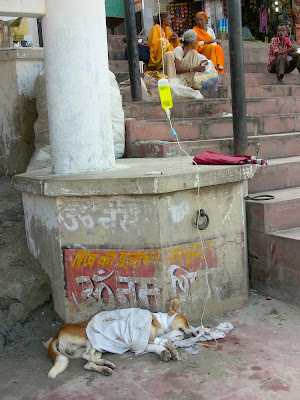Having settled Yashoda into Rani Park in Kathmandu, I
would visit her every other day or so. She was in good hands now in the care of
DREAMS, as were the other cows and calves who had come to settle there. Walking
the streets in these cities, overcrowded with people, dogs and cows, one is
going to come across problems. And I did not have to go very far to find the
next set of “problems…”.
Just outside the newly formed cow sanctuary, were a group
of the saddest looking dogs I had ever seen. Hairless, depressed, itchy, run
down, and full of TVT’s. What’s a TVT? You may ask. It is a transmittable
venereal tumor. In other words, a sexually transmitted disease, that leaves a
giant tumor looking growth on the dogs’ organs. The females look as though the
uterus has fallen out, and the dogs just look like they have a horribly
enlarged, mangled, gnarly penis. It can do all sorts of horrible things inside
the body as well as outside, but, the good news is, it is highly treatable.
So, by now, my remaining time was running short in Nepal
and I was anxious to return to Mother India …I can only stay away so long. What
to do? I had met a lovely woman on previous visits who was doing local work in
her village. It was worth a call to get information from her as to which vets
might I be close to, and get at least started on this. Well, the rain of
miracles continued. Kate came out to meet me at the site, and, shocked as I was
to see all these dogs, quietly commented … “Wait a minute, I took a dog from
this area some weeks ago with the same problem.”
We now had an actual case of “Before” and “After.”
She turned out to be so lovely Kate did not have the heart
to bring her back, and was not aware of the extent of the problem in the area.
We did a quick survey, took photos, and quickly got one male I had been
searching for into the vet’s office. Kate agreed to keep him for follow up
care.
I knew this wasn’t enough, and knew it was not fair to
burden one person with such an enormous project, and who would pay for all
this…? So, I contacted some lovely
people I had met in Pokhara on a previous visit who had an organization called
HART; Himalayan Animal Rescue Trust. They do amazing work in Pokhara and the
outlying villages, and I thought it was worth a shot to bring this to their
attention.
One email got a quick reply, of sure, we can help with the funding. Kate Clendon, of Kopan Community Animal Care, then agreed to continue the treatments of these dogs.
“My” work had never been so easy!
There were local people who had shown great interest in seeing these dogs improve. They were incredulous when we showed them “before and after” photos, and wanted to see success in the condition of their community dogs. And there was, and so it is!
To see the transformations in these dogs health, lives, and spirit is a joy to behold.
Next


+of+nepal+027.jpg)










+of+nepal+025.jpg)





